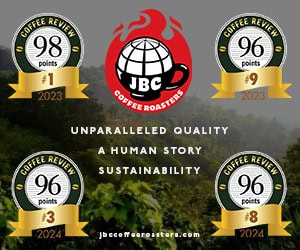Most members of the panel loved this coffee. Favorite adjectives: Aroma: caramelly and floral. Acidity: sweet and bright. Body: creamy and full. Flavor: floral, fruity, complex, balanced. Aftertaste: clean and resonant. Two panelists dissented, one of whom acknowledged the floral notes but dismissed them as "past-their-prime lilacs."
A classically bright yet sweet cup shimmering with seductive floral and wine-like fruit notes. This coffee attracted lavish praise from the panel: "fruity, floral, working well together"; "noble fruit notes!"; "[light] body but very clean like a great Pinot"; "rich, sweet, very aromatic." Given such enthusiasm, why didn 't this fine coffee attract a higher aggregate rating? Perhaps owing to its relatively light body, perhaps owing to the barest hint of astringent imbalance in the acidity.
Low-key, with a pungent intrigue in the nose that most panelists identified as nut, but which hinted at something more carnal. I was reminded of a combination of bouillon and prunes. Another panelist was less specific but more evocative: "Odd perfume notes that linger on the tongue. Musky, sweaty flavor."
I suspect only a slight astringency in the aftertaste prevented this Papua New Guinea from pushing up near the top of the ratings. Panelists liked its smoky aroma ("brownies baking" said one), its soft sweetness, and its understated character. Its rather metallic, salty astringency was barely detectable, but, once observed, distracting.
"A sweet, inoffensive little cup of coffee. No bells and whistles here," wrote one panelist. At first I was inclined to agree, but this soft, subtle coffee eventually won me over with its relaxed richness and striking lavender-like floral tones. Other panelists agreed. Perhaps no bells and whistles, but some pleasant warbling.
This sweet, deep-toned coffee with its pruny fruit notes edging toward chocolate attracted considerable praise, though some panelists expressed ambivalence: "some character but not too interesting next to others"; "[a kind of] sweet, fruity flavor that I don 't much care for." Perhaps a faded mustiness restrained this coffee 's considerable potential.
Panelists described a clean-tasting, agreeable coffee that was perhaps too agreeable, low-key to a fault. "Good balance, but not much to balance," complained one panelist. "Nothing really to grab onto," wrote another. Finished well, with a hint of chocolate, and the cup seemed to strengthen in character a bit as it cooled.
Very uneven from cup to cup. The best cups: low-toned, smooth, with a touch of spicy, clove-like pungency and a sweet, cocoaish finish. The less-than-best cups: bland with a slight but disturbing astringency.
An agreeably sweet coffee with pungent bottom notes, but wildly uneven from cup to cup. A grassy, green taste marred some cups; others clearly displayed the overripe-edging-on-rotten taste of ferment. Some combined both problems, in a sort of bouquet of defects.
Split vote, split coffee. The yeas responded to a bright, brisk, floral-and-fruit-toned richness with sweet cedar innuendoes. The nays were disturbed by hard, off-tasting undertones, perhaps a baggy mustiness.
A coffee whose interesting sweet fruit tones ("apricot" hazarded one panelist) edge into ferment, the overripe-cum-rotten flavor caused by sugars that prematurely ferment in the coffee fruit, tainting the bean inside the fruit. Complicating the ferment is a related off taste that some panelists tolerated and described with terms like "tobaccoey" and others condemned as "animal-like" and "skunky." In short, a promisingly sweet, complex coffee gone wrong.










